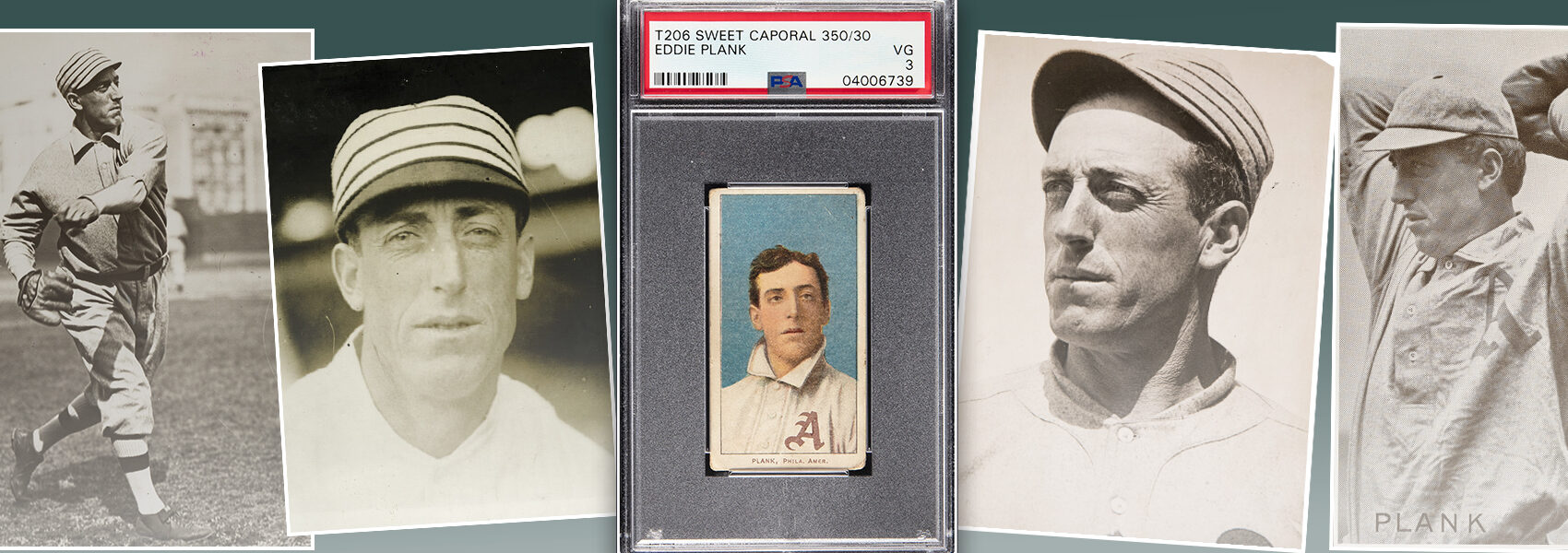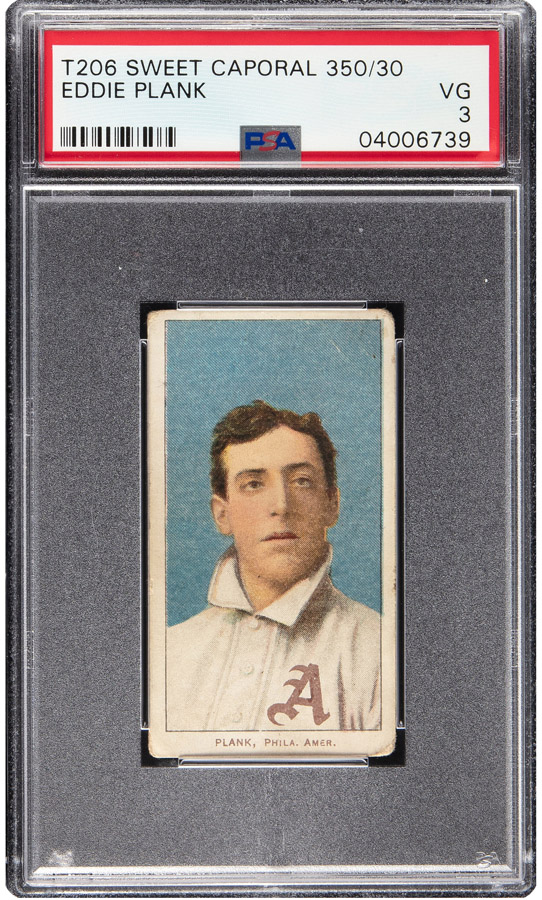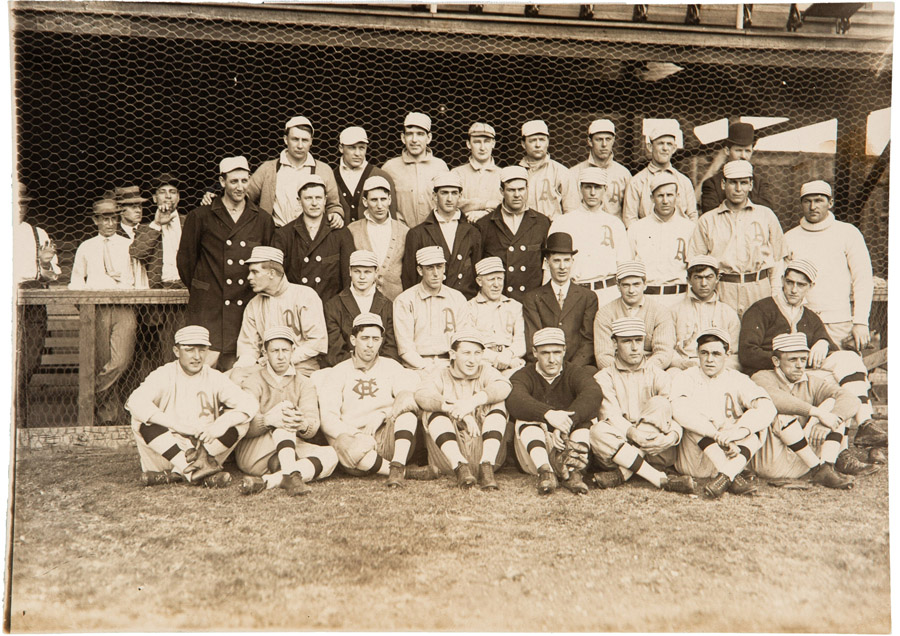ALTHOUGH THEORIES ABOUND, THE COVETED COLLECTIBLES’ RARITY REMAINS AN ENIGMA MORE THAN A CENTURY AFTER THEIR DEBUT
By Robert Wilonsky
Of pitcher Eddie Plank’s prowess, there is no dispute. Look no further than the Baseball Hall of Fame, whose page on the man called Gettysburg Eddie heralds: “For 17 years, Eddie Plank staked his claim as one of the best left-handers in baseball history.” There, too, is an endorsement from player and manager Eddie Collins, who notes that Plank “was not the fastest, not the trickiest and not the possessor of the most stuff. He was just the greatest.”
The statistics – 326 games won, a 2.35 career ERA, three World Series titles with the Philadelphia Athletics and a 1.38 ERA over more than 54 innings pitched during those championship games – add up to one hell of a career.
Eddie Plank photographed by Louis Van Oeyen in 1910. The Type 1 photograph sold for $3,120 in a February 2024 Heritage auction.
Plank died at 50 on February 24, 1926, two days after he suffered a stroke in his sleep. Twenty years later, one of the Deadball Era’s greatest pitchers was finally inducted into the Hall in 1946. And three years after that, Ogden Nash included him in his poem Line-Up for Yesterday: An ABC of Baseball Immortals alongside Babe Ruth, Ty Cobb, Dizzy Dean, Christy Mathewson and Honus Wagner.
P is for Plank,
The arm of the A’s;
When he tangled with Matty
Games lasted for days.
Plank and Wagner, especially, are forever intertwined, as their baseball cards rank among The Hobby’s rarest and most coveted – well, one, at least.
Wagner’s T206, manufactured between 1909-11 and included with packs of cigarettes and tobacco, needs no introduction here. Books have been written about The Card. In fact and in fiction, men have gone to prison over Wagner’s card, of which there are at most 50 surviving examples out of the scant 200 (or fewer) printed. Artists have remixed it. It’s the Grail. The GOAT. The Mona Lisa on cardboard. Your mom’s probably even heard of it – just maybe not about the story that Wagner either killed the card because he didn’t want kids pulling his face out of packs of tobacco or because he wanted more money from the American Tobacco Company for the right to use his image.
Plank was at the pinnacle of his MLB career when the American Tobacco Company issued this 1909-11 T206 card featuring the hard-throwing southpaw. This example, graded PSA VG 3, is available in Heritage’s January 24-25 Winter Sports Card Catalog Auction.
Plank’s T206 is nearly as hard to find as Wagner’s. The combined grading companies have certified about 100 surviving examples of the Hall of Fame pitcher, who was already a superstar when the T206s began rolling off the printing press in 1909. By all rights, his card should have existed in multitudes. Yet it’s almost as much a rumor as Wagner’s. And every few years – which is to say, whenever one is newly discovered or appears at auction – there are stories that attempt to answer why.
“And yet, still, to this day, nobody knows for sure,” says Heritage Auctions Executive Vice President Joe Orlando. “There are different theories, but none has ever been verified.”
Because it was more than a century ago. Because baseball cards were not yet big business. Because no one kept records. And because, for the longest time, no one cared. Not even the Hall of Fame can offer a guess: When in 2019 it posted to Facebook a photo of a Plank T206 on loan from Arizona Diamondbacks managing general partner Ken Kendrick’s famed collection, the Hall noted only that it “has inspired numerous theories about what prompted its scarcity.”
Among the theories: Plank, like Wagner, wasn’t a smoker and didn’t want to be associated with the product. But that conjecture doesn’t smoke well with some experts.
Pre-War Cards notes that “a problem with this theory is that Plank has cards in both the initial 150 Series as well as the later 350 Series. If his cards were not to be included and were yanked quickly during the 150 Series production, why was he also found in the 350 Series?”
This Philadelphia Athletics team photograph, which sold for $28,800 in a February 2019 Heritage auction, was taken in 1909, the first year the T206 Plank was produced.
Another theory is that the card was discontinued for some reason and then later reinstated. T206 Resource, presenting a thorough history of the card’s production for various brands (including Sweet Caporal, Piedmont, Hindu and El Principe De Gales), insists that just wasn’t the case.
“Of the available subjects that could be printed at this time, just more than half were included and just less than half were not printed,” they write. “Again, Plank was in this large no-print group. Of these two print runs, many subjects from print group 1 were absent from one or the other, with a group of subjects that included Plank being absent from both.”
The most popular theory concerns a broken or subpar printing plate, “resulting in many of the cards being destroyed since they could not pass quality control,” PSA notes. “In addition, many of the known examples are found with poor centering from top to bottom. The centering can be so severe that it will cut into the text along the bottom.”
The consensus is: Yeah, that’s probably it.
Maybe.
Or not.
“One reason I kind of lean against it is because Plank has only one card in the set,” it says on Pre-War Cards. “Think about it – if a damaged printing plate were really the reason for these cards being pulled, you would almost expect that he would appear on at least one other card in the set. I say that because many other Hall of Famers received two, three, and even four cards. If they had to remove this Plank card, it seems logical they would try to include at least another. Plank having more than one card would have seemed likely, anyway, given his talent. But that is even more the case if the makers of the set realized that most of his cards were unusable.”
In the words of Nate Bargatze’s George Washington, nobody knows.
The T206 Resource coughs up this shrug: “It is not known if a cease and desist of some kind was presented to the companies responsible for the set or if they simply chose to remove the card on their own.”
In the end, it doesn’t matter. They didn’t make a lot of Plank’s cards. And they ain’t making any more.
And, of course, there are even rarer T206s, such as the Joe Doyle N.Y. Nat’l card where he’s got his hands above his head, of which there are 10 known examples. But the Plank belongs alongside the Wagner, as each was an elite player, a future Hall of Famer, not merely a guy who wound up on some misprinted card back when quality control wasn’t the first, second or 18th concern.
“Going back as far as when I was a kid collecting in the 1970s and ’80s, the Plank T206 was already regarded as a significant card,” Orlando says. “It was featured in publications and on posters displaying rare and historically important cards. There was the Wagner and then, a tier down, the Plank. The only difference is now, people are surprised at how tough it is to find a Plank. There must be some meaningful explanation for why the production numbers weren’t as great as the others in the set. But no definitive reason has ever been confirmed, so it’s not likely we will ever know.”
Orlando says one thing is certain: The T206 Plank is treasured. But it remains overlooked and undervalued.
For now.
“The Wagner has taken on a life of its own as ‘The Mona Lisa of collecting,’” Orlando says. “But you could certainly make the argument the T206 Plank appears on its surface to be underappreciated. It should be worth much, much more than it is. Before population reports, you were going on the word of dealers and rumors among collectors. Now, the grading population data has made the Plank more appealing. It’s not quite as elusive as the Wagner. But it is considerably closer in scarcity than most would assume.”
 ROBERT WILONSKY is a staff writer at Intelligent Collector.
ROBERT WILONSKY is a staff writer at Intelligent Collector.




